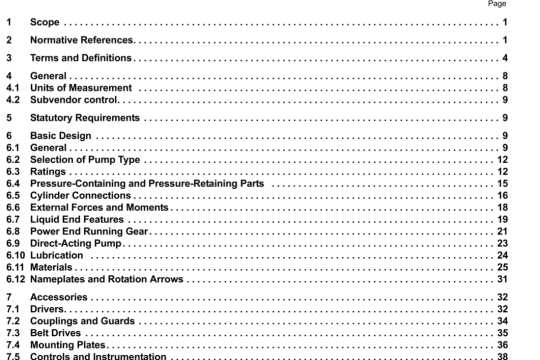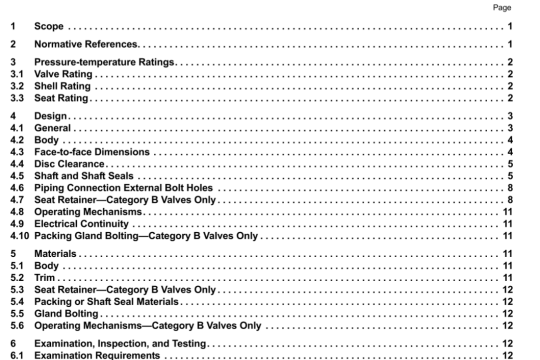API RP 11S4:2002(2013) pdf download
API RP 11S4:2002(2013) pdf download.Recommended Practice for Sizing and Selection of Electric Submersible Pump Installations.
6.2.3 Pump Thrust
The pump shaft thrust should he calculated to use in seal chamber section thrust bearing design selection. While the limitation to he checked is a consideration of the seal chain- her section, the source of the thrust is the pump. The magnitude of thrust depends on the number of stages employed and the mechanical configuration of the being used. The common form of pump is conunonly referred to as a floating impeller pump. in which the pump impellers are free to travel axially somewhat. In being free to travel, the individual diffusers carty the thrust generated directly by each intpeller. The differential pressure developed by the pump acting on the cross sectional area of the puntp shaft causes a separate thrust loud that must be accommodated for by the seal chamber section thrust hearing. Again, this loud should be calculated for worst case, shut-in conditions,
Thru,st calculations for fixed or compression type pumps should be based on data provided by pump manufacturers and worst case operation (e.g.. shut-in).
6.2.4 Variable Speed Design
While variable speed drives provide additional flexibility and adjustability to ESP installations, they contplicate pump selection, Variable speed lives capitalize on the behavior of centrifugal pumps at different speeds (where will affinity law equations be located). As a general rule, the design should begin at the highest frequency to be sure the equipment will be sufficient to handle situations such as lifting kill fluid upon stan-up. However, the best efficiency rate should be targeted for the frequency at which the longest running time is expected in the application. While this can be calculated by hand, the use of computer softwiwe is recommended to handle the conversion of pump performance data at variable speeds.
6.2.5 Gassy Wells:High Vapor-liquid Ratios
As explained ahose, hand calculations are inadequate for applications with more than a few peivent of vapor in the fluid flow stream at the inlet of the pump. In these applications. contputer software should be used to handle the mote coinpies inflow and multiphase flow calculations and niultiphase pump performance calculations based (in [‘VT data and conelations. Specific attention should be paid to avoid sizing pumps for normal operating conditions that are incapable of lifting heavy kill fluids or completion fluid’. during stanup.
There are design option.v for handling the gas, either through the pump or separating it out of the flow stream prior to entering the pump. There are special pumps made to handle a high perrentage of free gas. Please consult with your nanufactwer to hnd out the free gas limitations on their equipment. Another design is the tapered pump. wharh uses seseral diffcrnt volumetric stages Ilarge flow capabilriy on bottom, smaller floss capacity on topl. As the fluid is coinpressible. the volume becomes smaller as it travels through the pump.
Gas s rators are also available. Consult with your manufa.-iurer to determine which ipe of separator is best for yow apphcalion. The user will also need to determine if the separator requires additional horsepower to function, This silue will be needed to properly size the motor,
6.2.6 Ab.’aslves
Abrasion resistant pump trim and features should be selected fur applications in which abrasive SOIiLLS, such as ‘and (grain size and shape is essential daia, sc-ale. etc., are espected. While there are many different designs asnilabk. manufacturers are generally able to help specify an adequate level of bearing and material options to mitigate abrasive wear concerns. The type and volume of sand dictates the materwis needed and its placement inside the pump.
6.3 CHECKLIST
a. Select the appropriate pump stage design fur the desired pump flow rate.
Ii. lktc,minc number of stages required.
c. Detennine power required by pump horscpowcrj
d. Ensure the pump shaft and housing strengths arc within acceptable limits.
e Ensure the proper metallurgy for ptuduced well fluid is selected,
7 Select Motor
A motor must deliver the seposs-ci required to run the pump, seal chamber section. and gas and water separator, if required. Important considerations include temperature limitation, casing size, length and size of cable, moter terminal voltage. motor current and also the well operating conditions.
The horsepower requlremenLs and the well conditions should be studied against the catalog listings to determine which catalog horsepower will satisfy his requirements. i.e.. should he use a smaller catalog horsepower to meet his requirements or a dc-rated larger horsepower or stick with the closest catalog horsepower. All possibilities will have different coal associations.




